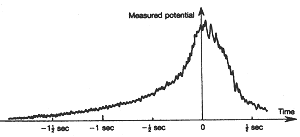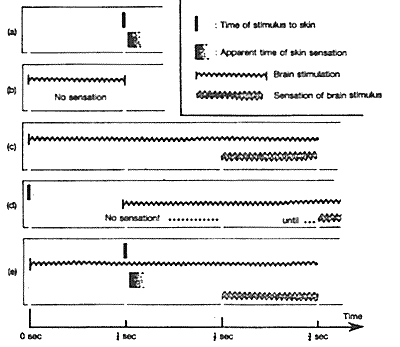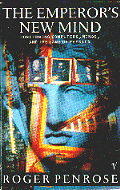 |
Chapter 10:Where Lies the Physics of the Mind?
|
THE TIME-DELAYS OF CONSCIOUSNESS
I wish, next, to describe two experiments (described in Harth
1982) that have been performed on human subjects, and which appear to have
rather remarkable implications for our considerations here. These have to
do with the time that consciousness takes to act and to be enacted. The first
of these is concerned with the active role of consciousness, and the second,
its passive role. Taken together, the implications are even more striking.
The first was performed by H. H. Kornhuber and associates in Germany in 1976.
(Deeke, Grotzinger, and Kornhuber 1976.) A number of human subjects volunteered
to have electrical signals recorded at a point on their heads
(electroencephalograms, i.e. EEGs), and they were asked to flex the index
finger of their right hands suddenly at various times entirely of their own
choosing. The idea is that the EEG recordings would indicate something of
the mental activity that is taking place within the skull, and which is involved
in the actual conscious decision to flex the finger. In order to obtain a
significant signal from the EEG traces, it is necessary to average the traces
from several different runs, and the resulting signal is not very specific.
However, what is found is remarkable, namely that there is a gradual build-up
of recorded electric potential for a full second, or perhaps even up to a
second and a half, before the finger is actually flexed. This seems to indicate
that the conscious decision process takes over a second in order to act!
This may be contrasted with the much shorter time that it takes to respond
to an external signal if the mode of response has been laid down beforehand.
For example, instead of it being 'freely willed', the finger flexing might
be in response to the flash of a light signal. In that case a reaction time
of about one-fifth of a second is normal, which is about five times faster
than the 'willed' action that is tested in Kornhuber's data (see Fig. 10.5).

Fig. 10.5. Kornhuber's experiment. The decision to flex
the finger appears to be made at time 0, yet the precursor signal (averaged
over many trials) suggests a 'foreknowledge' of the intention to
flex.
In the second experiment, Benjamin Libet, of the University
of California, in collaboration with Bertram Feinstein of the Mount Zion
Neurological Institute in San Francisco (Libet et al 1979), tested subjects
who had to have brain surgery for some reason unconnected with the experiment
and who consented to having electrodes placed at points in the brain, in
the somatosensory cortex. The upshot of Libet's experiment was that, when
a stimulus was applied to the skin of these patients, it took about half
a second before they were consciously aware of that stimulus, despite the
fact that the brain itself would have received the signal of the stimulus
in only about a hundredth of a second, and a preprogrammed 'reflex' response
to such a stimulus (cf. above) could be achieved by the brain in about a
tenth of a second (Fig. 10.6). Moreover, despite the delay of half a second
before the stimulus reaches awareness, there would be the subjective impression
by the patients themselves that no delay had taken place at all in their
becoming aware of the stimulus!(Some of Libet's experiments involved stimulation
of the thalamus, cf. p.491, with similar results as for the somatosensory
cortex.) Recall that the somatosensory cortex is the region of the cerebrum
at which sensory signals enter. Thus, the electrical stimulation of a point
of the somatosensory cortex, corresponding to some particular point on the
skin, would appear to the subject just as though something had actually touched
the skin at that corresponding point. However, it turns out that if this
electrical stimulation is too brief - for less than about half a second -
then the subject does not become aware of any sensation at all. This is to
be contrasted with a direct stimulation of the point on the skin itself,
since a momentary touching of the skin can be felt. Now, suppose that the
skin is first touched, and then the point in the somatosensory cortex is
electrically stimulated. What does the patient feel? If the electrical
stimulation is initiated about a quarter of a second after the touching of
the skin, then the skin touching is not felt at all! This is an effect referred
to as backwards masking. Somehow the stimulation of the cortex serves to
prevent skin-touching sensation from being consciously felt. The conscious
perception can be prevented ('masked') by a later event, provided that that
event occurs within about half a second. This in itself tells us that the
conscious awareness of such a sensation occurs at something like half a second
after the actual event producing that sensation!

Fig. 10.6. Libet's experiment. (a) The stimulus to the
skin 'seems' to be perceived at about the actual time of the stimulus. (b)
A cortical stimulus of less than half a second is not perceived. (c) A cortical
stimulus of over half a second is perceived from half a second onwards. (d)
Such a cortical stimulus can 'backwards mask' an earlier skin stimulus,
indicating that awareness of the skin stimulus had actually not yet taken
place by the time of the cortical stimulus. (e) If a skin stimulus is applied
shortly after such a cortical stimulus, then skin awareness is 'referred
back' but the cortical awareness is not.
However, one does not seem to be 'aware' of such a long time-delay
in one's perceptions. One 'way of making sense of this curious finding might
be to imagine that the 'time' of all one's 'perceptions' is actually delayed
by about half a second from the 'actual time' as though one's internal clock
is simply 'wrong', by half a second or so. The time at which one perceives
an event to take place would then always be half a second after the actual
occurrence of that event. This would present a consistent, albeit disturbingly
delayed, picture of sense impressions. Perhaps something of this nature is
borne out in a second part of Libet's experiment, where he initiated an
electrical stimulation of the cortex first, continuing this stimulation for
a good while longer than half a second, and also touching the skin while
this stimulation was still going on, but less than half a second after its
initiation. Both the cortical stimulation and the touching of the skin were
separately perceived, and it was clear to the subject which was which. When
asked which stimulus occurred first, however, the subject would reply that
it was the skin-touching, despite the fact that the cortical stimulation
was in fact initiated first! Thus, the subject does appear to refer the
perception of the skin-touching backwards in time by about half a second
(see Fig. 10.6). However, this seems not to be simply an overall 'error'
in the internally perceived time, but a more subtle rearranging of the temporal
perception of events. For the cortical stimulation, assuming that this is
actually perceived no later than half a second after its initiation, seems
not to be referred back in this way. From the first of the above experiments,
we seem to deduce that conscious action takes something like a second to
a second and a half before it can be effected, while according to the second
experiment, consciousness of an external event does not seem to occur until
half a second after that event has taken place. Imagine what happens when
one responds to some unanticipated external occurrence. Suppose that the
response is something that requires a moment's conscious contemplation. It
would appear, on the basis of Libet's findings, that half a second must elapse
before consciousness is called into play; and then, as Kornhuber's data seem
to imply, well over a second is needed before one's 'willed' response can
take effect. The whole process, from sensory input to motor output, would
seem to require something like two seconds! The apparent implication of these
two experiments taken together is that consciousness cannot even be called
into play at all in response to an external event, if that response is to
take place within a couple of seconds or so!
THE STRANGE ROLE OF TIME IN CONSCIOUS PERCEPTION
Can we take these experiments at their face value? If so, we appear to be
driven to the conclusion that we act entirely as 'automatons' when we carry
out any action that would take less than a second or two in which to modify
a response. [Note Penrose is not saying WE ARE automatons - but that the
implication here is that we are - he argues against that view - a view held
by the AI community - that we are just remarkably complex automatons - his
view holds that something else emerges FROM that complexity and makes use
of the true freedom in QP - I agree with him - we are not automatons - and
only via QP can one make this claim.Paul Davies appears to concur.] No doubt
consciousness is slow-acting, as compared with other mechanisms of the nervous
system. I have, myself, noticed occasions such as watching helplessly as
my hand closes the car door a moment after I have noticed something within
the car that I had wished to retrieve, and my willed command to stop the
motion of my hand acts disturbingly slowly - too slowly to stop the closing
of the door. But does this take a whole second or two? It seems unlikely
to me that such a long timescale was involved. Of course, my conscious awareness
of the object within the car together with my imagined 'free willing' of
the command to stop my hand could all have occurred well after both events.
Perhaps consciousness is, after all, merely a spectator who experiences nothing
but an 'action replay' of the whole drama. Similarly, on the face of it,
there would, on the basis of the above findings, be no time for consciousness
to be playing any role at all when, for example, one plays a shot at tennis
and certainly not at ping-pong! No doubt the experts at these pursuits would
have all the essentials of their responses superbly preprogrammed in cerebellar
control. But that consciousness should be playing no role at all in the decision
as to what shot should be played at the time is something that I find a little
hard to credit. No doubt there is a lot in the anticipation of what one's
opponent might do, and many pre-programmed responses might be available to
each possible action of the opponent, but this seems to me to be inefficient,
and a total absence of conscious involvement at the time is something that
I would find difficult to accept. Such comments would be even more pertinent
in relation to ordinary conversation. Again, although one might partly anticipate
what the other would be saying, there must often be something unexpected
in the other's remarks, or conversation would be entirely unnecessary!
